German Bread (Authentic Vollkornbrot)
This post may contain affiliate links. See my disclosure policy.
A thoroughly authentic German Bread Recipe (Vollkornbrot)! This delicious traditional German whole grain seed bread is nutrient dense with a fabulous texture and positively packed with flavor. This makes a large loaf that freezes well so you can conveniently grab some whenever you’re in the mood.

Authentic German Bread (Vollkornbrot)
Few things are better than a freshly baked loaf of bread slathered down with butter and some good jam. That’s true for crusty breads with fluffy interiors and the more hearty, dense breads that I also know and love from Europe. Here is a German bread that is beloved throughout Germany and is also widely enjoyed in Austria and Switzerland. It features a grain called Einkorn that is used throughout much of western Europe, but feel free to substitute other grains according to your preference.
Dense, chewy, packed with nutrition and full of flavor, this whole grain German brown bread (Vollkornbrot) is wonderful with your choice of butter, jam, Nutella, cheese, or cold cuts.
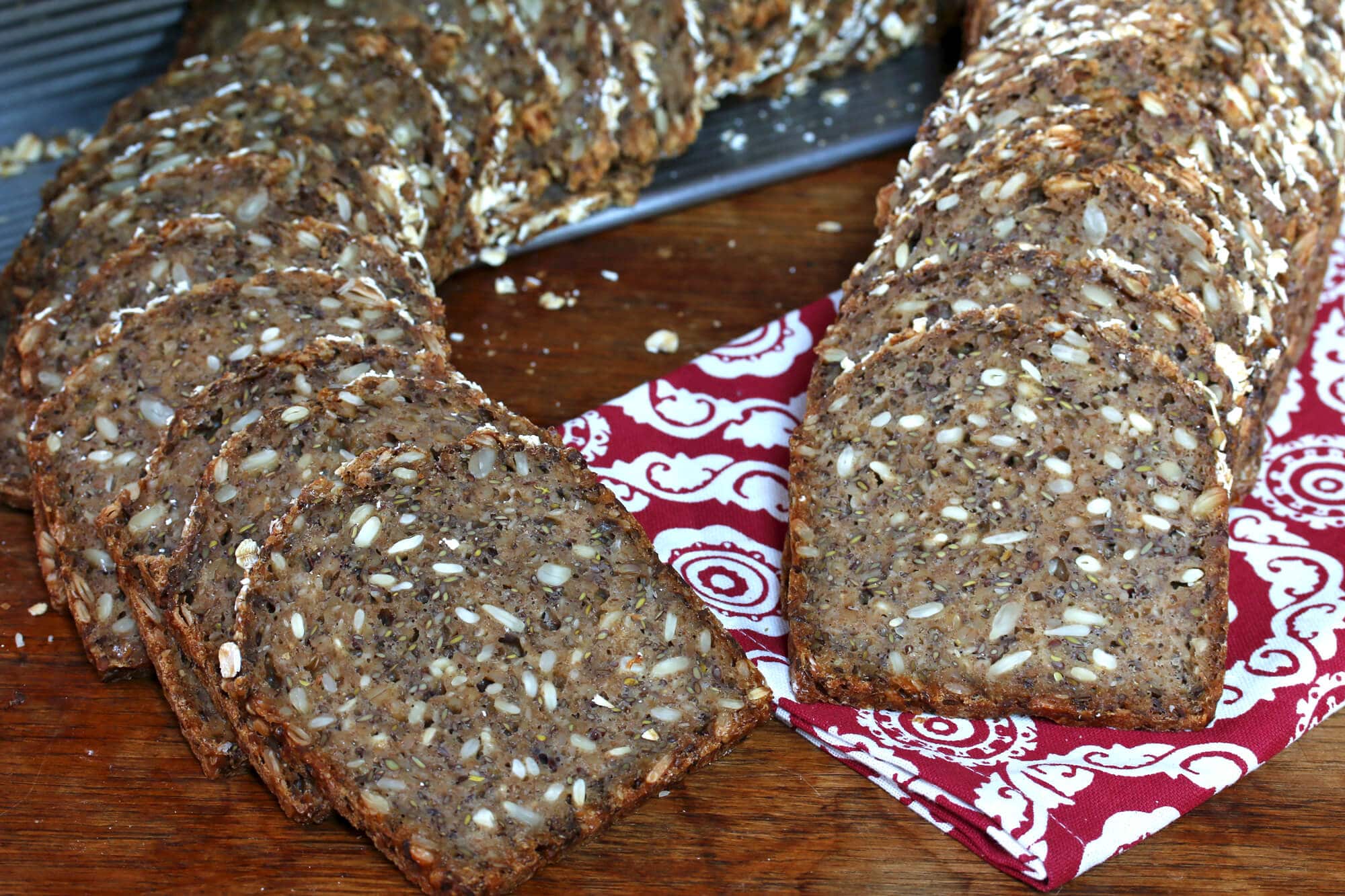
Have you heard of the grain einkorn before? Modern day wheat over the centuries has undergone a series of genetic changes for the purpose of increasing yield and gluten content. It’s almost unidentifiable compared to its ancestor (and my guess is that is why gluten issues are a more recent occurrence). Einkorn is the most ancient form of wheat on earth and hasn’t undergone these genetic changes. It is the purest form of wheat we have. You can purchase einkorn online HERE.
The advantages of einkorn: Most agree it tastes better than wheat and is much easier to digest, even easier than spelt. Compared to the gluten in modern day wheat, it contains a structurally different composition of gluten that the body is able to digest more easily. In fact, some people with gluten issues who have switched to einkorn have found that they’re able to tolerate and digest it with ease.
Even visually there’s a difference between wheat and einkorn. Though there are size variations within different types of wheat, generally most wheat (left) is longer in length than einkorn (right). Einkorn also has a deeper caramel color.
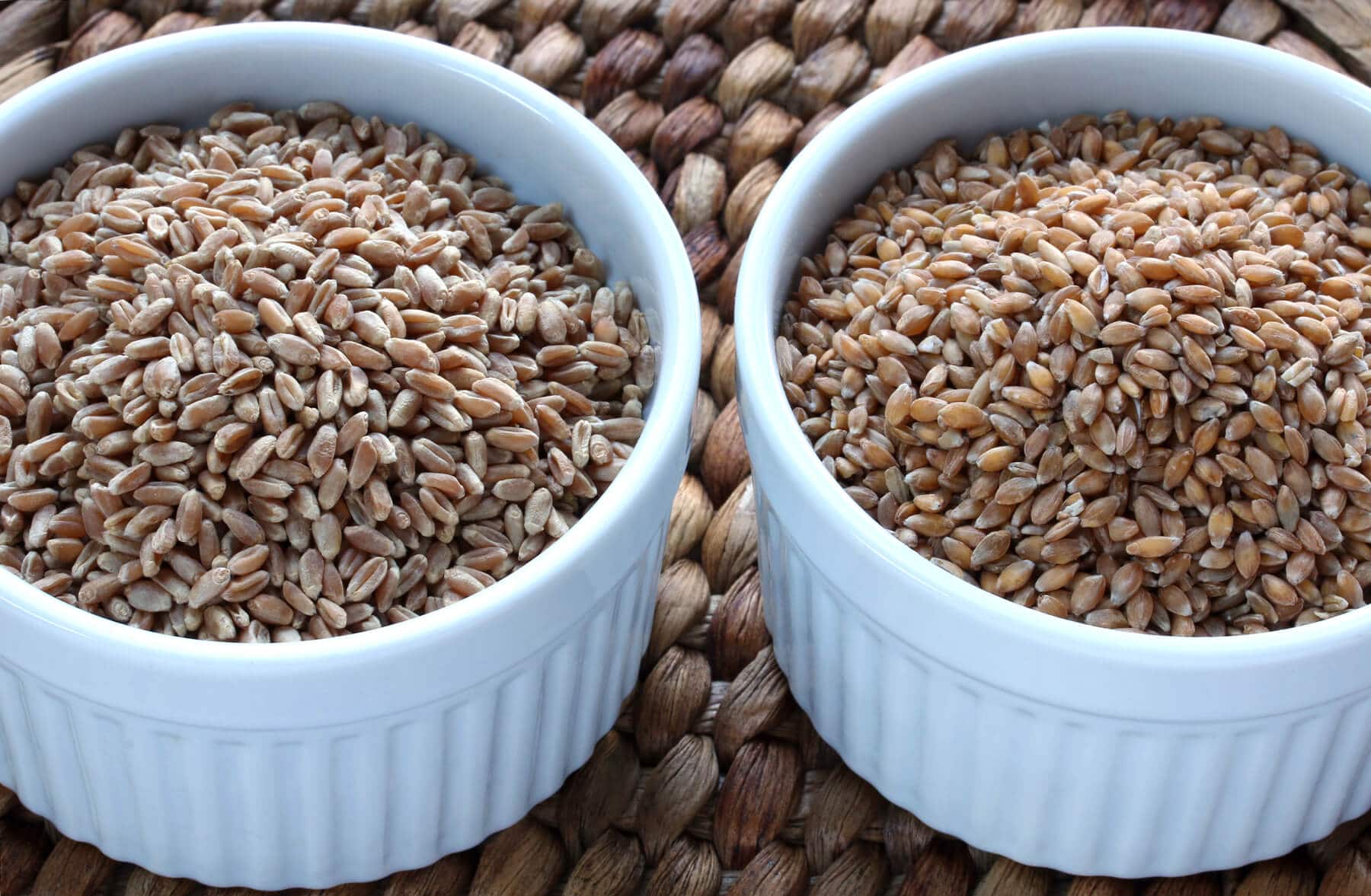
It’s unfortunate that as wonderful as Einkorn is, and common as Einkorn is in many places throughout western Europe, it’s almost unheard of here and very few places sell it. And for that reason it’s also much more expensive here in the U.S.. Hopefully that will change as it becomes more common. The same was true of spelt for a long time and though it’s still far less common than wheat here in the U.S. its price-point has gone down.
I buy all of my grains, including einkorn, in bulk. I take out what I need for a few weeks at a time and store the rest in a dark, cool place. It saves money that way and I have easy access to everything I need. And I LOVE being able to grind my own grains fresh as needed and make up my own fresh baking mixes!
My German-made KoMo grain mill is the pride and joy of my kitchen. German engineering at it’s best, the KoMo grain mill is simply awesome. You can grind your grains as fine or as coarsely as you like. With a 12-year warranty this thing is a work-horse and does a magnificent job. I use it nearly every day grinding my own flours, making cornmeal and a variety of mixes. I cannot recommend it highly enough.
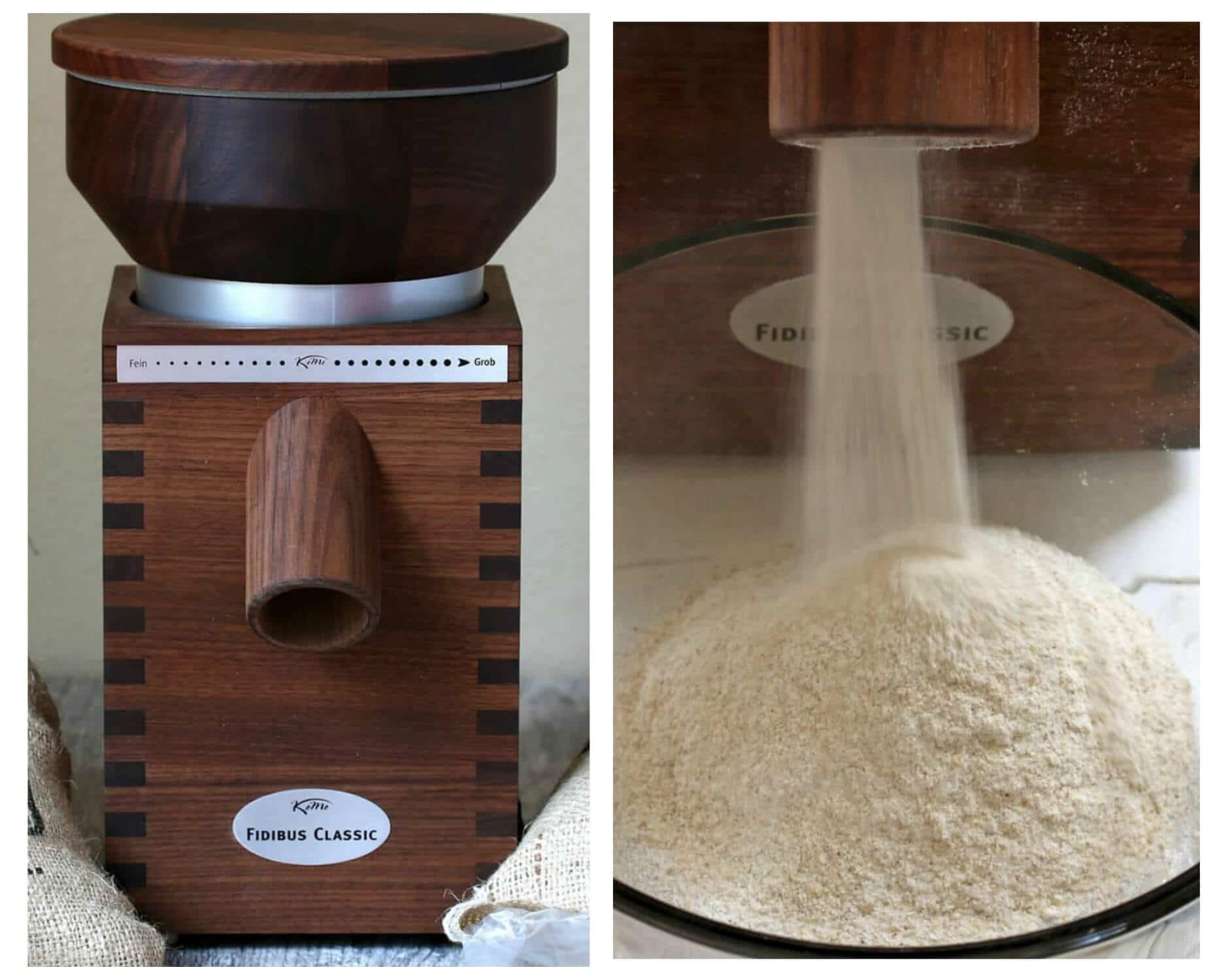
This traditional German bread uses a combination of whole einkorn berries and ground einkorn flour. Whether you’re grinding your own grains or buying the flour already ground, you’re absolutely going to love the texture and flavor of this wonderfully hearty, rustic and thoroughly authentic German bread!
German Sourdough Bread
A couple of our readers have reported back about using sourdough starter instead of yeast. To make this a sourdough Vollkornbrot omit the yeast, add 200 grams of active sourdough starter, and reduce the flour by 100 grams and the water by 100 grams. Give the batter a full 24 hour ferment.
German Bread Recipe (Vollkornbrot)
Let’s get started!
Dissolve the yeast and sugar in the lukewarm water and let sit for 5-10 minutes until frothy. (See above if you prefer to use sourdough starter.)
Place all of the dry ingredients in the bowl of a stand mixer. (You can do this by hand if you prefer.)
NOTE: I personally don’t pre-soak the whole or cracked grain berries and let my batter ferment for a full 24 hours which softens the berries. Depending on the age of the grains you’re using they may require a pre-soaking in order to be adequately soft. If you wish you can pre-soak the grains overnight (pour hot water over them and let them sit) and then thoroughly drain for an hour or so.

Add the yeast mixture along with the buttermilk and beer. Knead on the bread setting (#2) for 10 minutes.
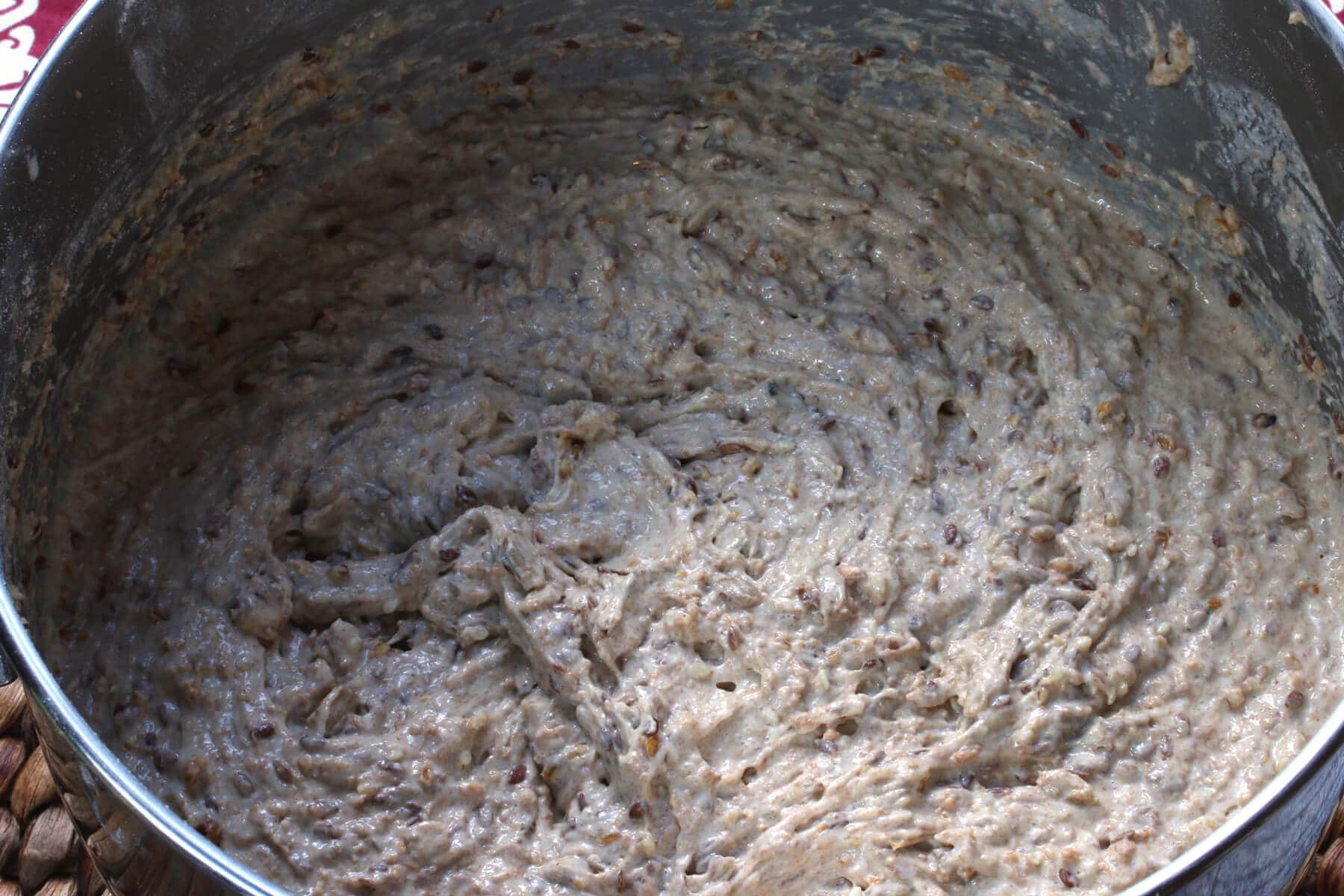
Scoop the mixture into a non-reactive bowl, cover loosely with plastic wrap and let it sit at room temperature for at least 8 hours, preferably longer, up to 24 hours (the longer the better for the whole grain berries to soften and for heightened sourdough properties. If you’re letting it sit for less than 24 hours, presoak the grains overnight in advance and drain thoroughly). Also, the longer it ferments the more liquid will be absorbed so less chances of a moist center after baking.
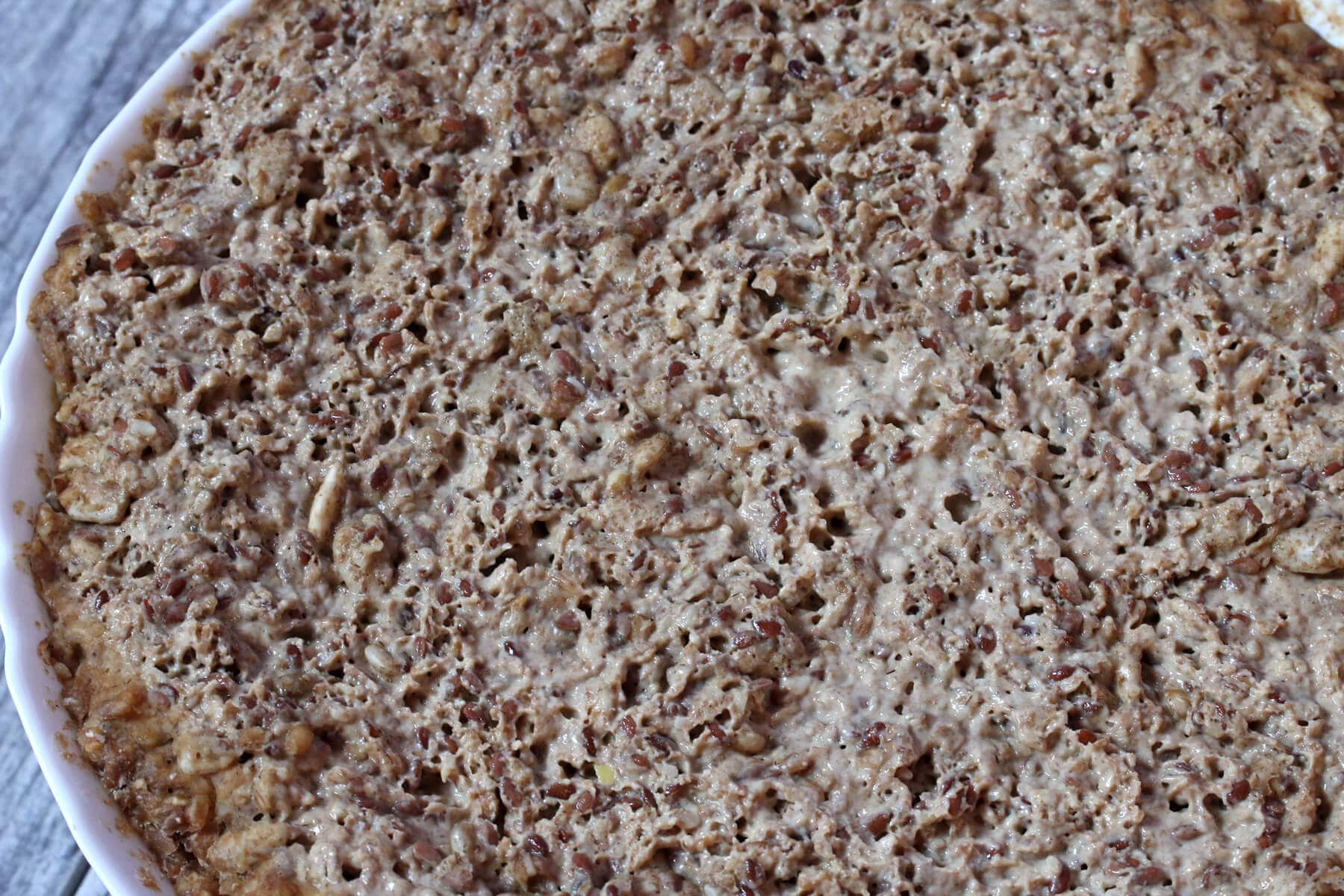
The mixture will be thick and gooey but will not resemble typical bread dough.
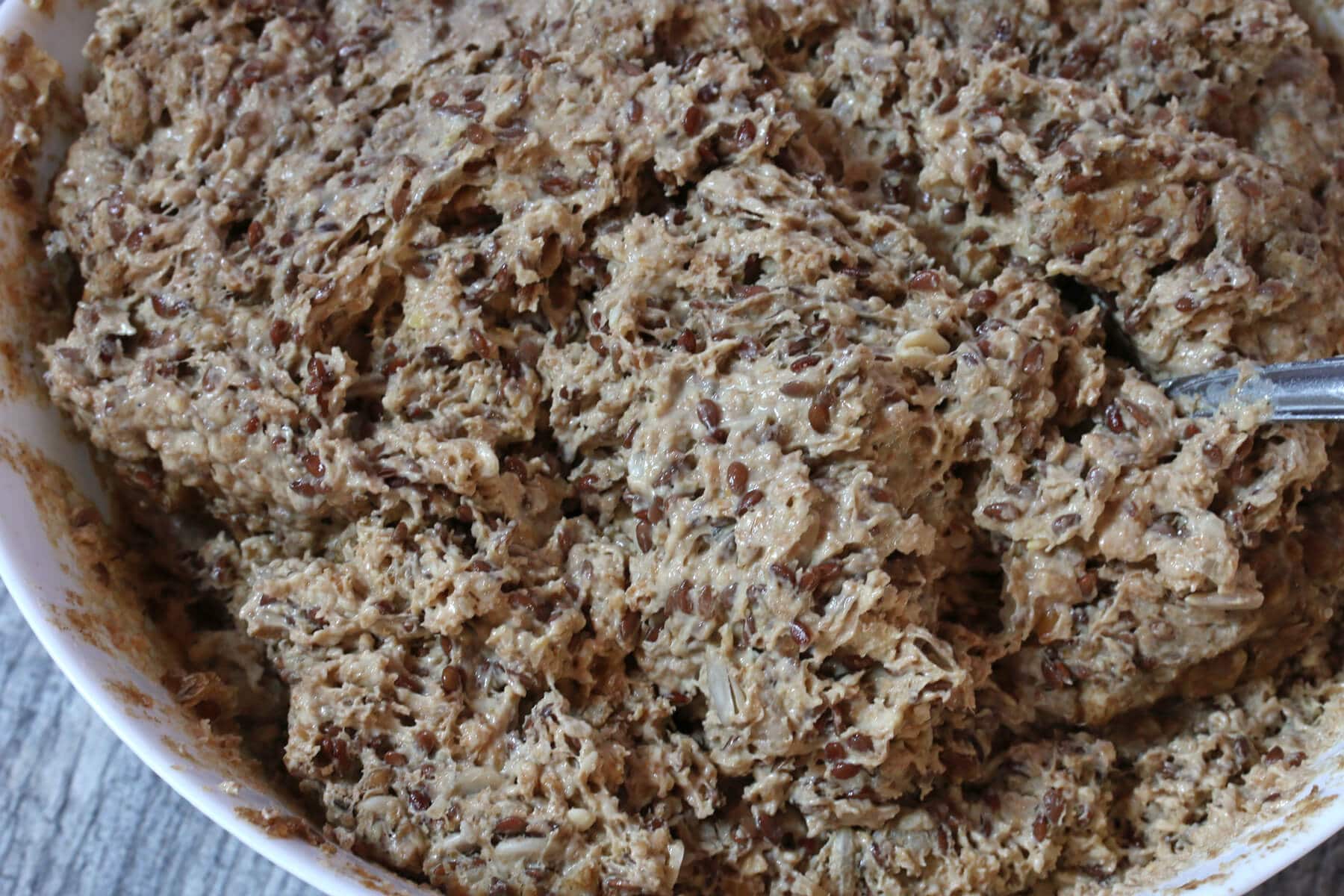
Scoop the mixture into a generously buttered Pullman Loaf Pan and smooth the top so it’s even.
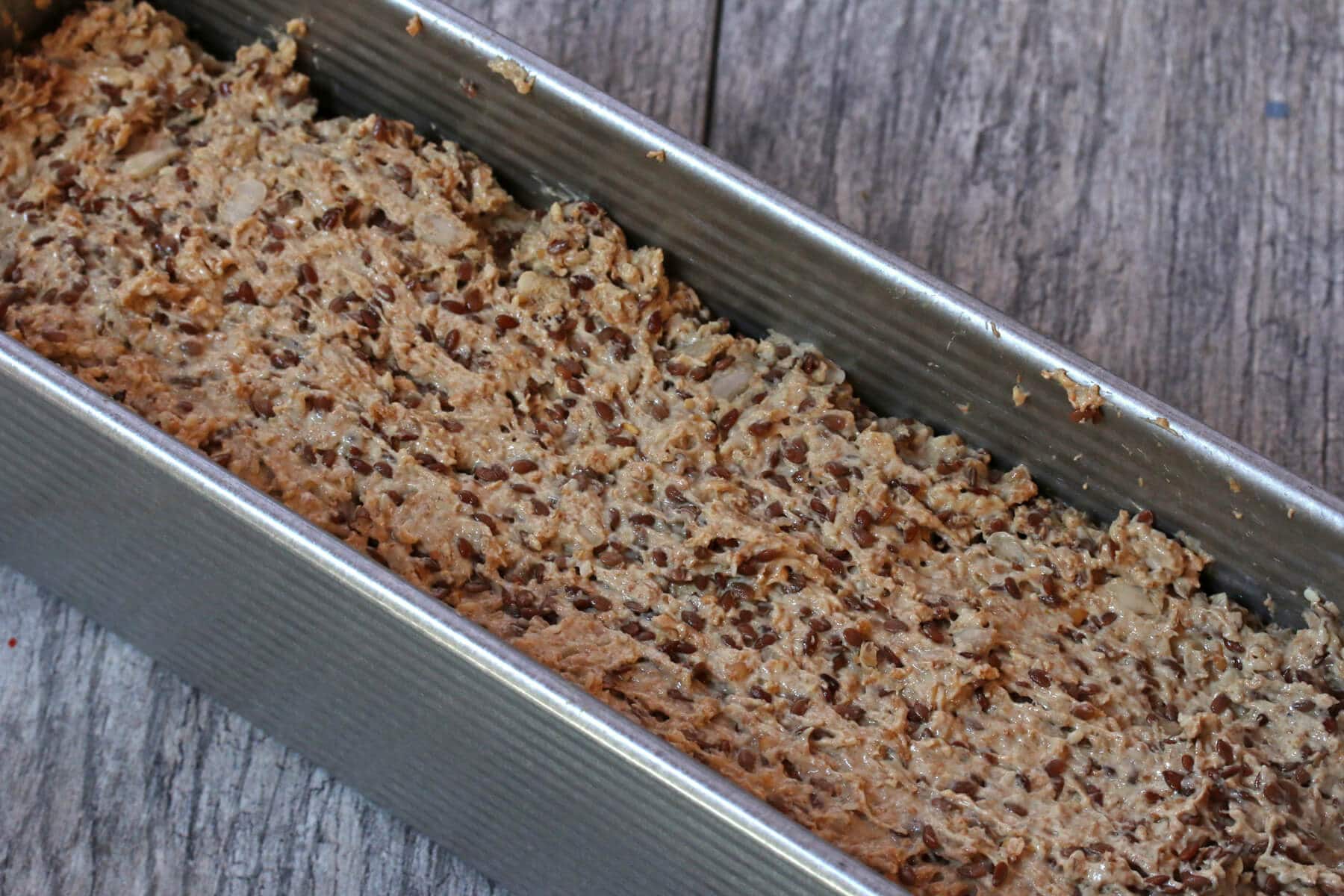
Baking this bread in a Pullman loaf pan yields those nice small, square slices of bread. But it also helps ensure that the center of the bread is fully cooked. Plus, when I’m making other breads that rise a lot, the Pullman has a top on it that slides shut to keep the bread compact (this Einkornbrot doesn’t rise a lot during baking so I don’t bother putting the lid on for it). It’s also the loaf pan that is used to make the famous French pain de mie bread. I like to use it for a lot of my heartier European style breads.
Sprinkle the top with rolled oats.
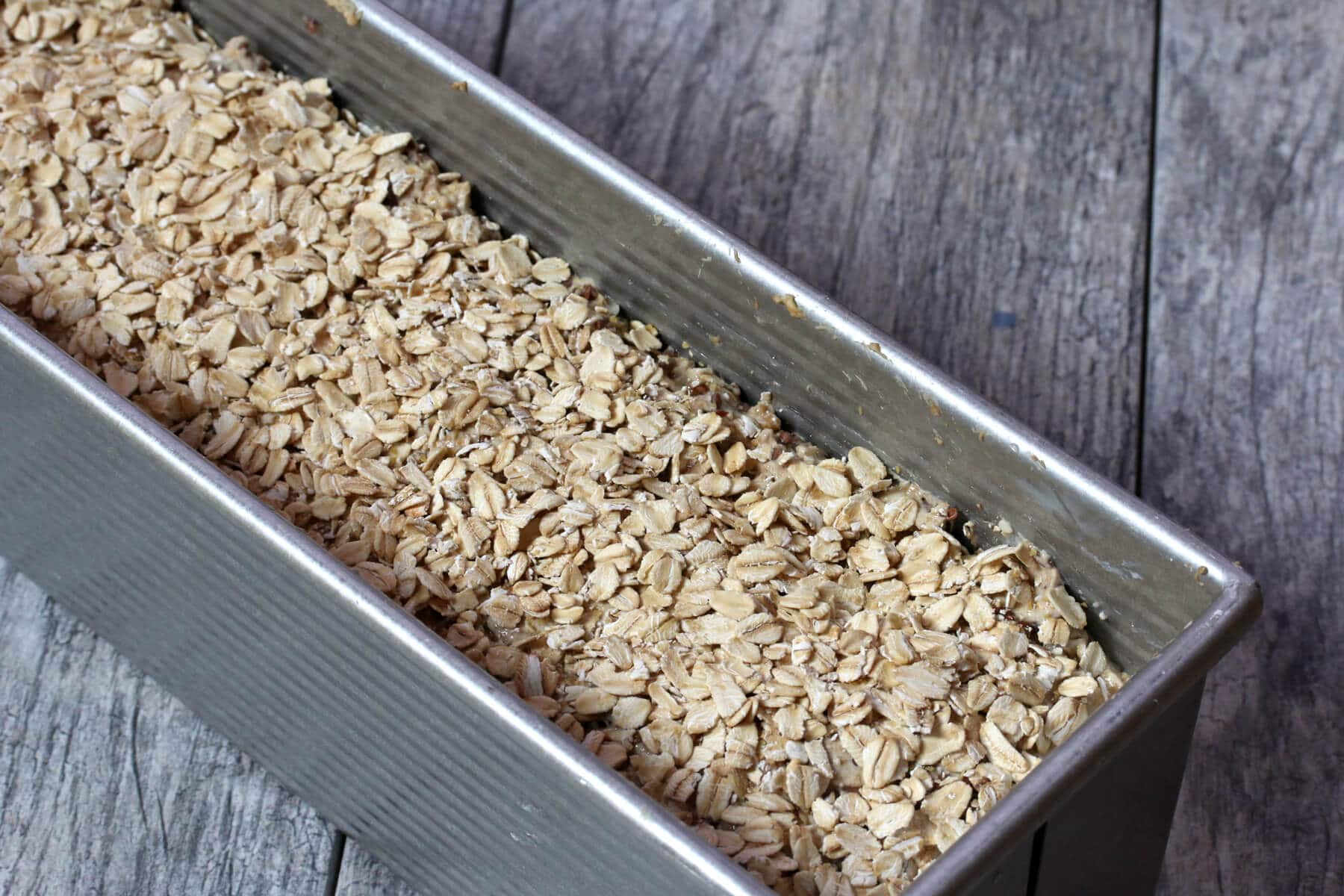
In an oven preheated to 350 degrees F, bake it on the middle rack for 100-120 minutes or until the center is done.
For best and most accurate results, use an instant read thermometer and aim for an internal temperature of 205-210 degrees F.
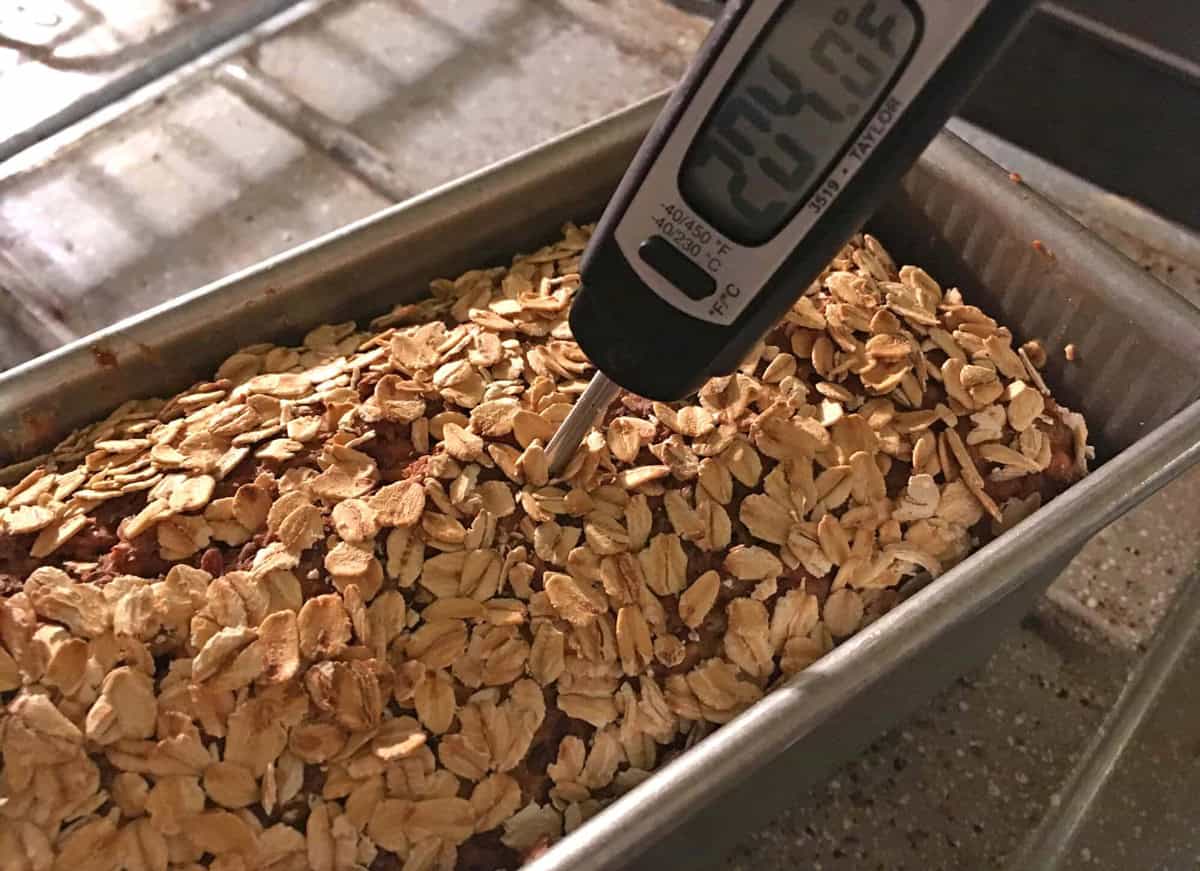
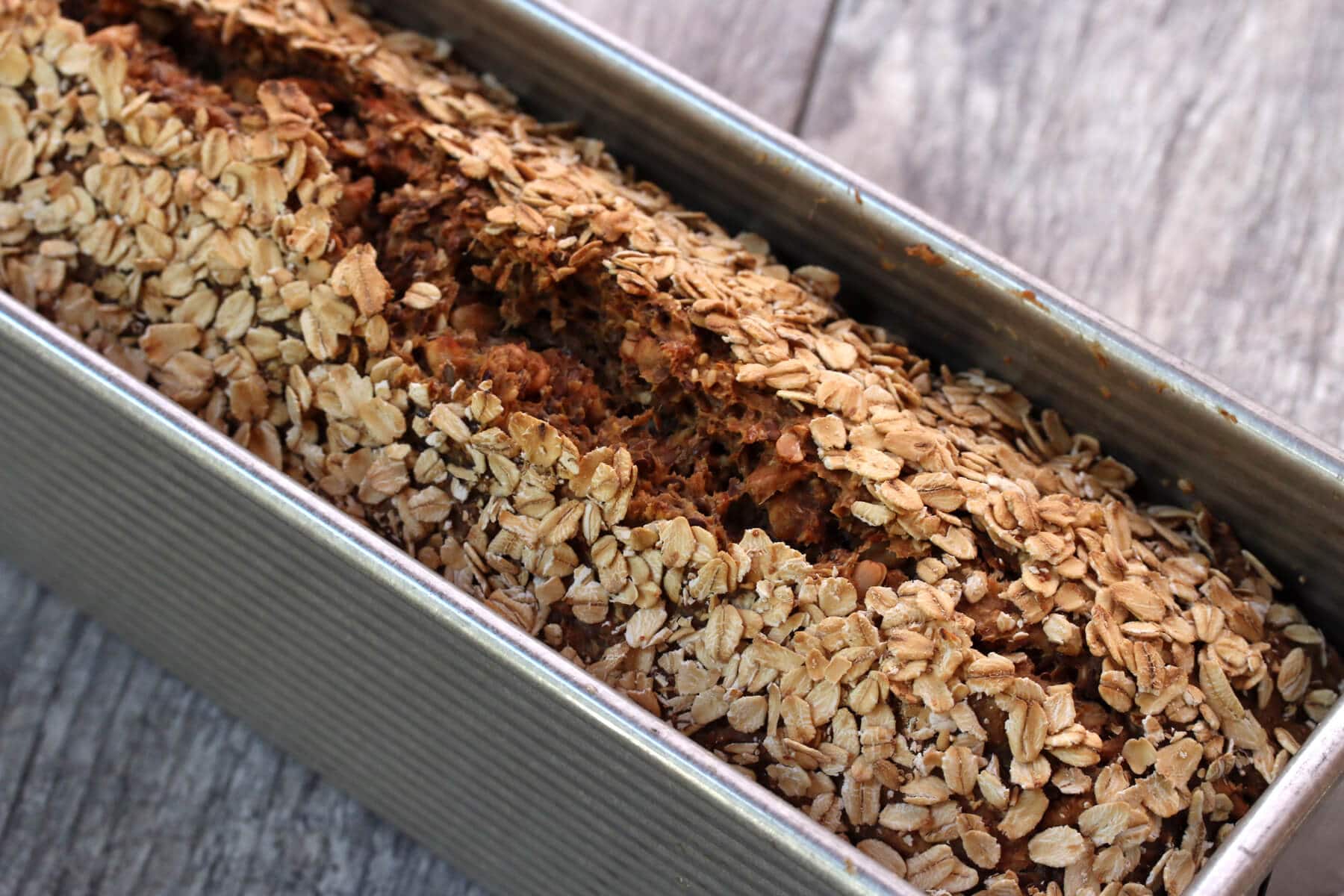
Let is sit in the pan for 5 minutes before removing it, then let it cool completely on a wire rack.

Once cooled you can slice the entire loaf in advance or slice as needed.

We have a decades-old Hobart commercial slicer that we picked up on Craigslist years ago. I used to be the manager of a delicatessen in England and Hobart is the gold standard in food slicers. In fact, the very same model that we have is on display at the Smithsonian!
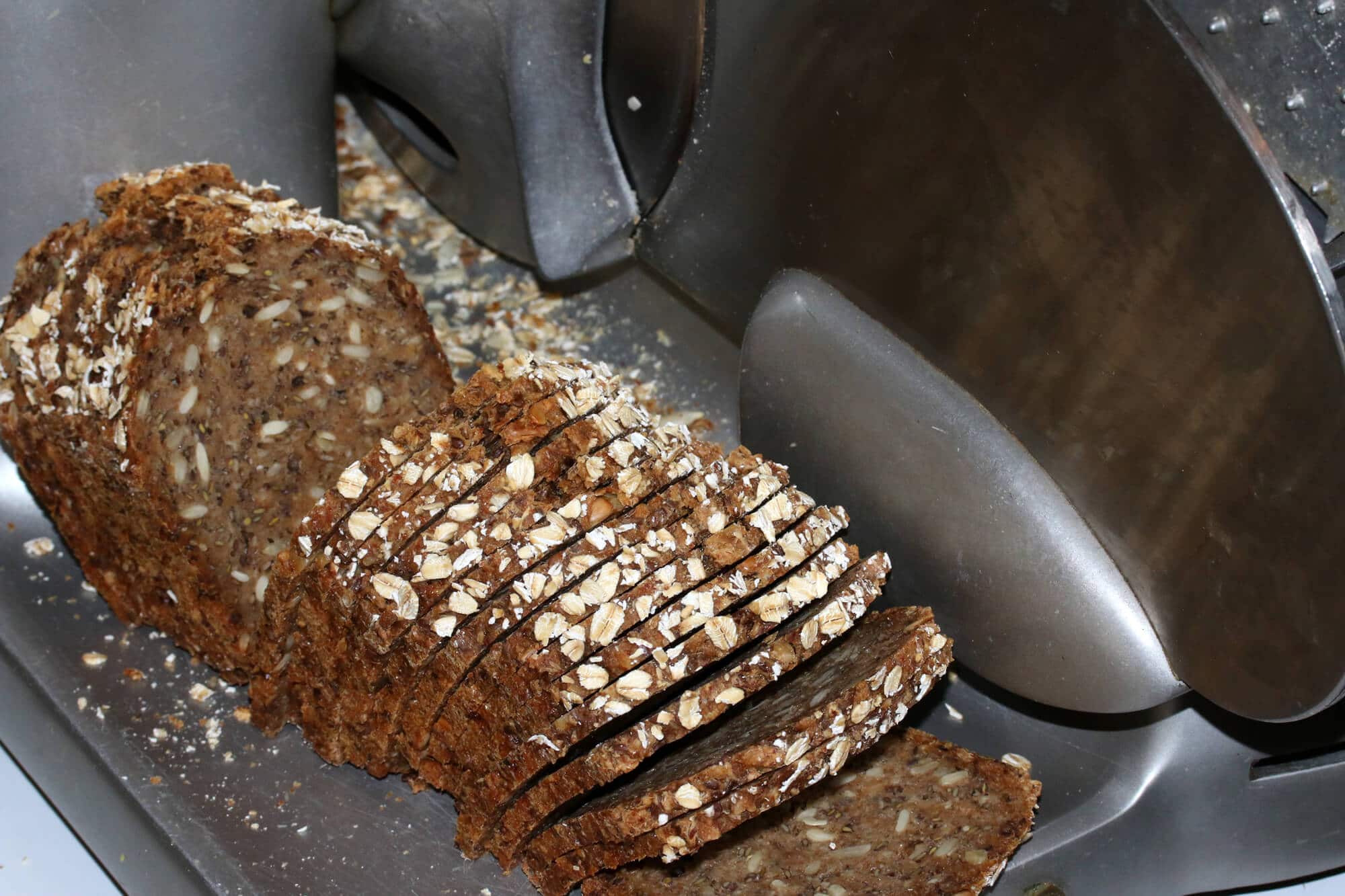
I realize we got lucky and most of you aren’t going to find a good-priced Hobart on Craigslist, but there are other good slicers on the market that are vastly cheaper and do the job. Chef’s Choice Slicers are consistently ranked at the top. I haven’t personally tried one, but they get excellent reviews. Having a good slicer to get clean, thin slices of bread that look like something you bought at a professional bakery is really nice. Plus, whenever I find chunks of cooked ham, turkey or cheese on sale I get those and slice them myself – it’s much cheaper than buying them at the deli.
At the very least you’ll need an excellent bread knife and for that my favorite knife, hands down, is the Cutco 9 3/4″ Slicer. It glides smoothly through bread and meat like no other.
Enjoy!

For more delicious bread from around the world be sure to try my:
- Lavash
- Injera
- Dosa
- Sourdough Naan
- Danish Rye Bread
- Crumpets
- Olive Rosemary Focaccia
- Skillet Cornbread
Save This Recipe
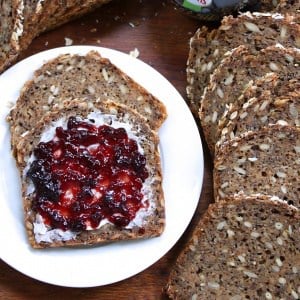
German Bread (Authentic Vollkornbrot)
Ingredients
- 4 1/2 cups einkorn flour (you can also use whole wheat, spelt, rye or combination)
- 1/2 cup whole einkorn berries , or wheat, spelt or rye berries (***See NOTE about soaking)
- 1 3/4 cups cracked einkorn berries , or wheat, spelt, rye (**See NOTE about cracking the grains **See NOTE about soaking)
- 1 cup whole flax seeds
- 1 1/2 cups sunflower seeds
- 1/4 cup sesame seeds
- 3 teaspoons salt
- 2 teaspoons dry active yeast ** see Note for sourdough substitution
- 2 tablespoons sugar , optional but recommended
- 2 cups lukewarm water
- 2 cups buttermilk , at room temperature
- 1 cup mild beer (optional, for a maltier flavor) , at room temperature (can substitute water or buttermilk instead)
- Rolled oats for sprinkling
Instructions
- Dissolve the yeast and sugar in the lukewarm water and let it sit for 5-10 minutes until frothy.
- Combine all of the dry ingredients in the bowl of a stand mixer. (You can do this by hand if you prefer.) Then add the yeast mixture along with the buttermilk and beer. Attach the dough hook and knead on the bread setting (#2) for 10 minutes. Scoop the batter into a large non-reactive bowl, cover loosely with plastic wrap, and let it sit at room temperature for at least 8 hours, preferably longer, up to 24 hours (the longer the better for the whole grain berries to soften and for heightened sourdough properties. Also the longer it ferments the more liquid will be absorbed so less chances of a moist center after baking.)
- Preheat the oven to 350 degrees F.
- Scoop the batter (it will be thick and gooey but not like regular bread dough) into a generously buttered 13x4x4 Pullman loaf pan and smooth the top to even it out. Sprinkle with oats. (Note: Baking this bread in a Pullman loaf pan yields those nice small, square slices of bread. But it also helps ensure that the center of the bread is fully cooked.) I always bake this without the lid on.
- Bake on the middle rack for 100-120 minutes or until the center is done. For best and most accurate results use an instant read thermometer and aim for 210 degrees F. Let the bread sit in the pan for 5 minutes before removing it, then let it cool completely on a wire rack before slicing it. To get clean, professional slices I highly recommend using a bread slicer.
Notes
- How to “crack” the whole berries: I use my grain mill to crack them by putting it on the coarsest setting. Another option is if you have a Vitamix and use the dry container – pulse the whole berries a few times until you get coarse pieces of einkorn. A powerful food processor will likewise do the job. Alternatively you can also place the whole berries in a ziplock bag and use a heavy object to pound them to break them up.
- Soaking the Grains: I personally don’t pre-soak the whole or cracked grain berries and just let my batter ferment for a full 24 hours which softens the berries, and I’ve always had great results. However, depending on the age of the grains you’re using (even if you just bought them they may have sat in the store or warehouse for a long time) they may require a pre-soaking in order to be adequately soft. If you wish you can pre-soak the grains overnight (pour hot water over them and let them sit) and then thoroughly draining.
- **Sourdough Substitution: To make this a sourdough Vollkornbrot omit the yeast, add 200 grams of active sourdough starter, and reduce the flour by 100 grams and the water by 100 grams. Give the batter a full 24 hour ferment.
Nutrition
Originally published on The Daring Gourmet December 11, 2019



















thank you so much for this recipe, i missed this bread so much as here in Canada they don’t sell it. i took a bite and felt catapulted to my home in Germany and i am so happy. its delicious.
I’m absolutely thrilled to hear that, Patrizia, thank you!
My Einkorn berries did not arrive yet and I am making the bread this weekend. Is there any substitute that I can use instead.
Hi Cynthia, yes that’s no problem whatsoever. You can use any variety of wheat grain of your choice – regular wheat, spelt, einkorn, rye, kamut, farro….or any combination of them.
The berries arrived and the bread came out delicious. I am slicing the bread. Could you tell me how you store you bread for best results? Thank you.
Wonderful, Cynthia!! I store it in an airtight container in the fridge.
This is my second time making this recipe. . Followed the recipe to a T and it has worked beautifully. . Thank you for the tip of internal temperature. . I will make the bread often as we all love this bread in my house!!!
I’m so thrilled to hear that, Linda, thank you!
Kimberly, I am in the process of making your bread for the first time. I have a couple of questions. You use 4 1/2 cups of flour. Is that sifted or packed cups? I am concerned I put in the wrong amount; what weight equivalent in grams do you suggest. Second, if I soak the grains, should I lessen the amount of water I add with yeast? The batter just seemed pretty runny when I put it in the pan. My bread is in the oven as I write so the outcome is unknown. Thanks in advance for some guidance.
Hi Scott, no, the flour is not sifted and no need to adjust the water amount. It is a batter, not a dough in the traditional sense of bread dough, so yes, it will be somewhat runny. How did your loaf turn out?
Oh that is good to know. I “poured” it out of the kitchen-aid into the bowl. I hope this works!!
Kimberly, I have now tried twice to make this bread and I have had a problem twice where the batter fell and left a hole in the top part of the bread. The first time was because I misread the beer amount and under measured the flour. but I followed the measured recipe the second time. In both cases I put 4 cups of boiling water on the grain, cracked grain and seeds. It soaked it all up and did not drain anything. I am wondering if it just has too much moisture. I love the smell and am bound and determined to get it right. This next time I am planning to not soak the grains and let the batter set for 24 hours to soften them. Thoughts?
Hi Scott, I would go with your plan to not soak the grains but be sure to let the batter ferment for 24 hours. Some of our readers have had better luck soaking them but I don’t and have had success every time.
The third time was the charm! It turned out beautifully this time. I learned a lot from my two previous failures. This time I measured by scoops not weight and I did not pre-soak any of the grains or seeds; I also proofed the batter for 24 hours; I baked it for 150 minutes getting it to 203 degrees; I wrapped it in an air proof cling wrap after baking for a day to soften the exterior. Given that I like the sour and barley flavors, I am thinking about using barley malt syrup in place of the sugar next time. What do you think? Truly an awesome tasting bread as it is! It paid off to keep after it despite early mistakes and learning.
Hi, is my math correct, that this loaf yields 6120 calories?
Some other questions come to mind: what is the longest amount of time you would suggest for fermentation? Is 2 days too long? Is kefir a suitable substitute for buttermilk, and will a darker type of beer work okay? Thanks so much!!
Hi Cameron, I would recommend 24 hours – try that first. Unless you like breads that are very “tart” I wouldn’t go beyond that. Beer: The flavor of the bread will already be very robust after the 24 hour fermentation time so again, unless you want an even stronger flavor I would stick with a mild beer. Same thing with the kefir, it will contribute a more pronounced sour flavor than the buttermilk will (I’ve made this kefir before). All of this comes down to personal preference though and what you’re used to – after experimenting a time or two you’ll be able to determine how you like it.
Kimberly,
So I made my first batch using kefir and Heineken for the beer. Everything else was per the recipe. Great success, best tasting bread I’ve ever eaten. Not sour at all, just mild smooth flavor. I ended up fermenting for about 32 hours or so.
Cameron, I’m so thrilled you enjoyed it and appreciate your feedback, thank you!
That’s correct, Cameron. It’s a huge loaf – roughly 40 slices.
I just made this recipe. I am loving it! I used only Einkorn. I accidentally weighed the Einkorn berries BEFORE processing them into cracked wheat, and the loaves came out perfect. I did let the dough sit for 24 hrs to ensure it would not be soggy and that the berries would absorb the liquids……the loaves came out perfect. I did not have the recommended pan so I used three small bread pans….they were full to the top when they went into the oven and they rose about 1/2″-3/4″ over the top. They look sensational. I used a dark beer….the taste was a little sour but not off putting at all. It is a hearty bread and both my husband and I are loving the crunch. Definitely use a digital thermometer…..I kept checking the temperature after the first sixty minutes of baking, since the loaves were small. They took a while, a hour and a half, possibly a little more. Just be patient and take the loaf out when checking the temp so as not to lose all the heat….Delicioso.
Thank you, Sue, I’m SO glad you and your husband are enjoying this bread and appreciate the feedback!
Hello, I really wanted to like this bread and was really excited about it, but to me, I found that the fermentation process made it almost inedible, unless I lathered it up with rich butter and jam – but then I wasn’t tasting the bread so much as the butter and jam, with the bread as my carrier of sweetness and butteryness. I hadn’t tasted fermented bread after living for a year and half in Germany, but had had plenty of thick, seedy bread, which is what I was looking for. Maybe I will try again without fermenting and re-review
Hi, I just tried it. Is it supposed to be so dense? Also, I used whole wheat grains and they just didn’t get soft, although I soaked them in boiling water overnight, drained them and again let the ‘dough’ rest for a full 24 hours before baking. Can I leave them out? If yes, what are the alternatives? I’m still on the hunt for a German bread recipe that’s perfect (tastes one years ago and haven’t forgotten the taste – simply divine!). Any and all suggestions will be welcome. I truly thought this was THE recipe. Perhaps I need to work at getting the einkorn. We don’t get it here (I’m in Lusaka). Thanks a bunch!